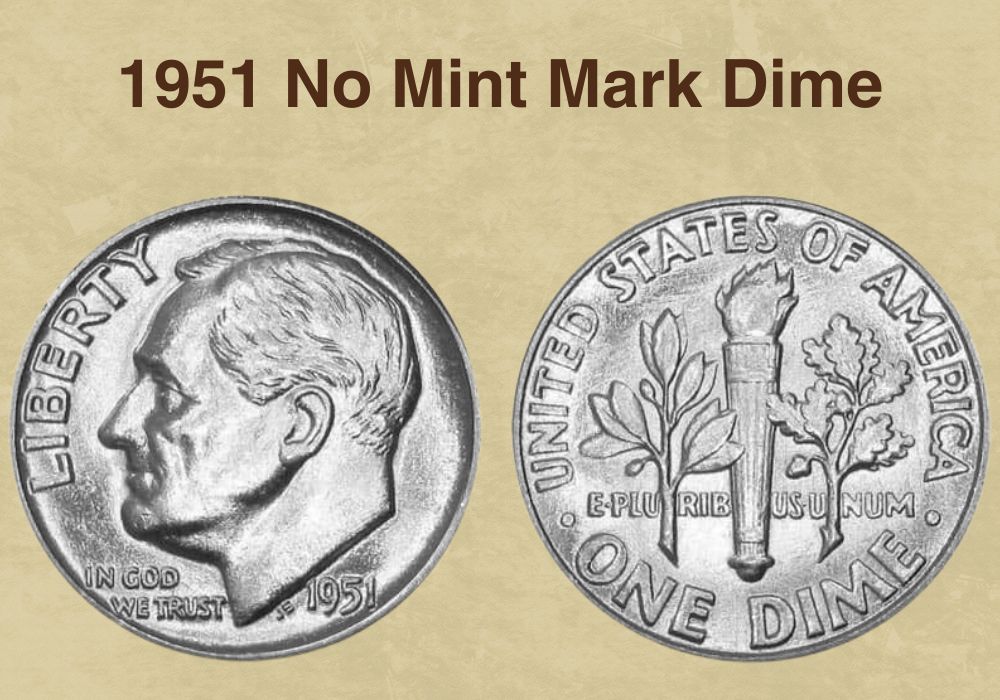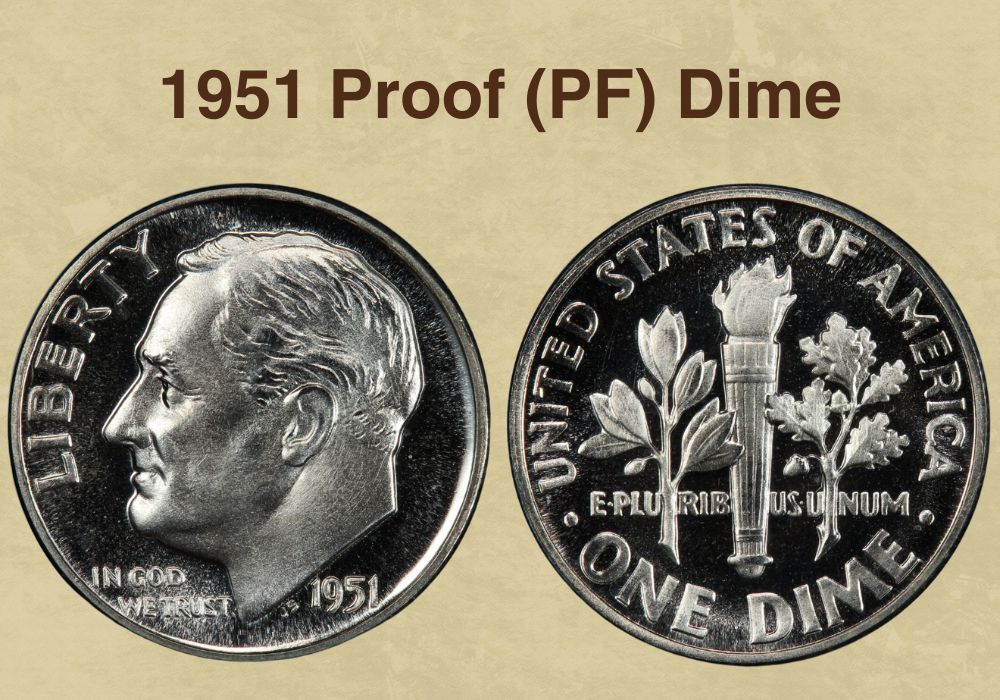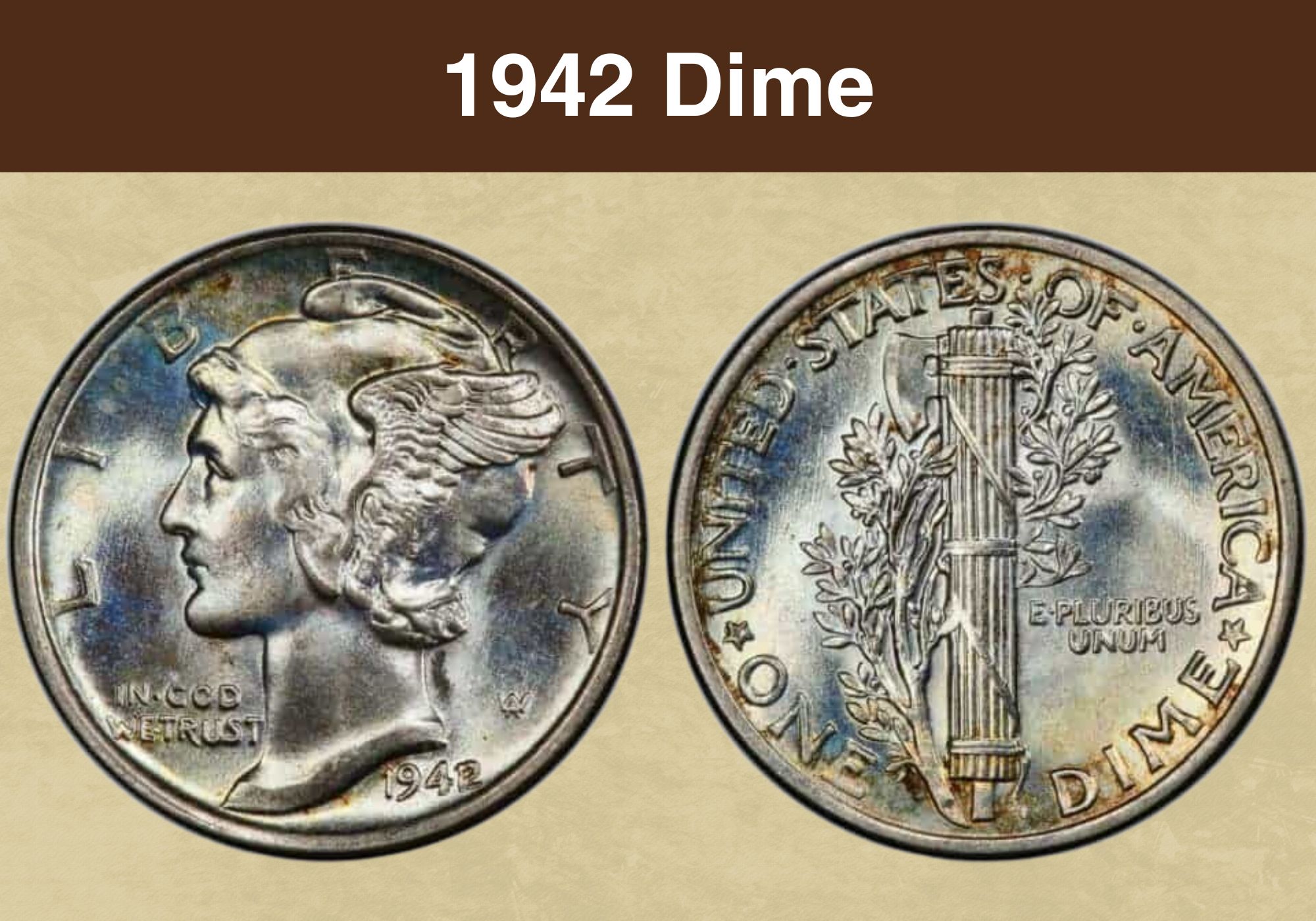
Coin Value Contents Table
Do you have a 1951 dime and wonder about its potential worth? If so, you have come to the right place! Sometimes you can have a small fortune in your change without knowing it! The 1951 dime is also known as the Roosevelt dime because it features his bust on the obverse!
Regarding the value, the 1951 dime is a silver coin, and when you have a coin made of precious metal, the value is higher than nickel or copper coins. In other words, even if it has a low grade, you can sell it for its worth in silver!
So, what is the 1951 dime value? Keep reading to learn more about this interesting coin!
1951 Dime Value Chart |
||||
| Mint Mark | Good | MS 65 | MS 67 | MS 68 |
| 1951 No Mint Mark Dime Value | $2.88 | $18 | $48 | $4150 |
| 1951 D Half Dollar Value | $2.88 | $20 | – | – |
| 1951 S Dime Value | $2.88 | $20 | $60 | $550 |
| PR 65 | PR 66 | PR 67 | PR 69 | |
| 1951 S Proof Half Dollar Value | $40 | $55-$70 | $70-$100 | $200-$500 |
Grading 1951 Dime
Most collectors or those new to the field, have issues with the coin grading system. The grading is highly important because it correlates with the coin’s value or, in other words, is dependent on it. The condition is the key to determining the accurate value.
| # | Grade |
|---|---|
| 1 | Basal State-1 |
| 2 | Fair |
| 3 | Very Fair |
| 4, 5, 6 | Good |
| 7, 8, 10 | Very Good |
| 12, 15 | Fine |
| 20, 30 | Very Fine |
| 40 | Extremely Fine |
| 50 | About Uncirculated |
| 60 | Mint State |
| 65 | Mint State |
| 70 | Mint State |
Please check our grading guides to know your coin scale, It’s the necessary step to know the exact value of your coin.
Check out now: How to Grade Roosevelt Dime?
1951 No Mint Mark Dime Value
History
The Roosevelt dime was first minted in 1946, soon after the death of Franklin Roosevelt, the 32nd president of the U.S. The president is best known for leading the country during trying times; the Great Depression and Second World War.
As most know, Roosevelt suffered from polio, an infectious disease caused by the polio virus, and was paralyzed from the waist down. He was diagnosed with the disease in 1921, and during his career, he tried to raise awareness and combat polio.
So, in 1938 he founded the non-profit organization “March of Dimes,” which also aims to improve the health of mothers and babies through various programs.
After the president died on 12 April 1945, placing him on the new dime design was the obvious choice.
The Roosevelt dime replaced the Mercury dime, minted from 1916 to 1945. Following the death of the beloved president, the idea for a new coin design was immediately initiated.
Considering that more than 25 years had passed since the Mercury dime was created and released into circulation, there was no need for Congressional approval. Creating the new dime design was given to the long-time Chief Engraver John R. Sinnock.
Obverse
As mentioned, the obverse features Roosevelt’s bust facing left. On the left side of the coin is the capitalized inscription “LIBERTY.” Underneath Roosevelt’s truncated neck is the American motto “IN GOD WE TRUST” on his left side.
On his right side, the mint year “1951” is struck, as well as the designer’s initials “J.S.”
Reverse
The reverse features a Roman torch at the coin’s center, with two branches on each side. The left branch is an olive, while the one on the right is an oak, symbolizing peace and victory.
The second American motto,” E PLURIBUS UNUM,” is struck seemingly over the Roman torch and olive and oak branch or between the elements mentioned above in the following sequence “E*PLU/RIB/US*U/NUM.”
There were several complaints about the coin’s reverse design when it entered circulation because it appeared too complex. Along the coin’s upper rim is the inscription “UNITED STATES OF AMERICA.” On the coin’s lower center is the denomination “ONE DIME,” with a dot on each side.
Details
Regarding the coin’s details, the 1952 dime is a silver coin, and its metal composition is 90% and 10% copper with a silver content of 2.25 or 0.072 troy ounces. After 1965, the metal composition changed from silver to an alloy of copper and nickel.
The weight of the 1951 dime is 2.50 grams or 0.08 troy ounces. Its thickness is around 1.35 millimeters or 0.053 inches with a reeded edge. The coin is round, and its diameter is 17.91 millimeters.
Mintage and Value
The 1951 dime was minted in San Francisco, Denver, and Philadelphia, with the total quality produced: 192,096,602. The highest mintage was in Philadelphia, 103,880,102. However, even though it is a silver coin, it is small and does not weigh much. Its melt value is around $1.83.
The dimes minted in Philadelphia do not have a mint mark. The value of the 1951 No Mint Mark dime in average or good condition is around $2.88, and it stays the same even for higher grades, such as fine, extra fine, or about circulated.
Professional Coin Grading Service (PCGS) says these can fetch a modest price in high-mint states, starting with MS 65. The 1951 No Mint Mark dime in MS 65 can cost between $11 and $35. According to the Numismatic Guarantee Company (NGC), the 1951 dime in MS 65 without the mint mark is $18.
In MS 67 and M.S. 67+, the dime can cost between $40 and $175. However, some specimens in the same grade were sold for far less, such as $21 at an auction in 2014. On the other hand, the same coin was sold for $259 at an auction in 2013.
The most attractive and rarest grade for this dime is MS 68. The estimated value for the 1951 No Mint Mark dime in MS 68 is $4,150. The auction record for the 1951 No Mint Mark dime in this high-mint state is $4,600, and the auction took place at the Superior Galleries in 2009.
1951 D Dime Value
The Denver Mint produced 56,529,000 dimes in 1951, making it the second-largest mintage in the series. The dimes minted in Denver have the “D” mint mark on the reverse, next to the Roman torch.
Despite the differences in total mintages, the value of the 1951 D dime does not differ from that of the 1951 No Mint Mark dime. So, the 1951 D dime in average condition is worth around $2.88
These are also remotely valuable in high-mint states. In MS 65, the value of the 1951 D dime is $20.
However, some specimens in the same grade were sold for $85 and some for $14. Therefore, it is vital to understand the market before going in with a certain coin.
At auctions, the value also depends on the customer’s idea of that coin’s worth, and given the bidding system, the customers can boost or drive the price down.
The most sought-after coin for this variety is the 1951 D in MS 68, the highest reported grade. The 1951 D dime in MS 68 costs around $1,350. The auction record for this dime variety in MS 68 was set at the Stack’s Bowers in 2011 when the collector paid $2,185 for the coin.
If you are familiar with the Roosevelt dimes, you might know that they have a special designation called Full Bands, which makes them highly valuable and attractive to collectors. This designation refers to the horizontal twin band on the Roman torch on the reverse.
This designation is given to the dimes in high-mint states starting with MS 60. You can find any variety of this coin with this designation, although some are rare and exclusive. A specimen of the 1951 dime with Full Bands in MS 68 was sold for $8,337 in 2009.
1951 S Dime Value
The Sand Francisco Mint had the lowest mintage in the series, 31,630,000. However, that does not affect the price significantly. The dimes minted in San Francisco have the “S” mint mark on the reverse. Similar to the previous two varieties, the 1951 S dime, in average condition, is worth around $2.
In MS 65, the value of the 1951 S dime is around $20. The 1951 S dime in MS 67 is worth around $60. However, some specimens of this variety in the same grade were sold for far less than $20 and others for $109.
The estimated value of the 1951 S in MS 68 is around $550. The auction record for the 1951 S dime in MS 68 is an astonishing $4,830. However, the same coin with the Full Bands designation was sold for $6,038.
1951 Proof (PF) Dime Value
The Philadelphia Mint also produced proof coins in 1951-57,500 pieces. In case you are unfamiliar with the term, the proof coins are the special or early specimens of a certain coin, created to check the dies and for archival purposes.
In most cases, proof coins are very valuable, and compared to regular strike dimes, there is an evident price difference. Before we dive into the values and grades, the proof coins have the “PF” OR “PR” abbreviation to indicate they are proof coins.
Proof coins are graded on the Sheldon scale, like regular coins. However, considering that they have a high-quality strike, they are graded from grades 60 through 70. Also, given that these are minted in Philadelphia, they do not have the mint mark. So, the 1951 proof dime in PR 64 is around $31.
In PR 65, expect to pay around $40. The price does not differ greatly for the PR 66 and even PR 67 and ranges between $55 and $100 or higher. The show’s star for this variety is the PR 69, the highest and rarest coins grade.
The price for the 1951 proof dime in PR 69 can range between $200 and $500. The proof coins have special designations such as “DCAM” and “CAM.” For a proof coin to be given the “DCAM” designation, it must have frosted devices on the obverse and reverse.
On the other hand, the “CAM” is attributed to a proof coin with a reflective surface, and its devices are not frosted or only frosted on one side of the coin. These designations boost the coin’s price significantly.
The 1951 PF CAM dime can cost between $40 and $700. The most valuable is the 1951proof dime with the DCAM designation, and it can cost between $800 and $3,000 or even more depending on the grade
The price for the 1951 proof DCAM dime in PR 69 is estimated at $12,000.
However, they usually fetch more at auction; such a specimen in the same grade was sold for an astonishing $23,000.
Also read: Top 17 Most Valuable Roosevelt Dimes Worth Money
Rare 1951 Dime Error List
In case you are not familiar with errors on coins, they usually boost the price depending on the coin type and its grade. Furthermore, some errors are rare and cost big bucks, so let’s check those out!
1951 Dime Re-punched Mint Mark Error
The re-punched mint mark (RPM) happens when the die used to strike the mint mark gets misaligned for the second strike and results in a slightly doubled image. This error can be very hard to notice, especially to the untrained eye.
The more the doubling effect is visible, the more value you can fetch from that coin. This error is confined to the “D” and “S” mint mark variety. The 1961 Full Bands dime in MS 65 with re-punched mint mark was sold for $70.
Also read: 13 Most Valuable Dime Errors Worth Money
Where to Sell Your 1951 Dime ?
Now that you know the value of your coins, do you know where to sell those coins online easily? Don’t worry, I’ve compiled a list of these sites, including their introduction, pros, and cons.
Check out now: Best Places To Sell Coins Online (Pros & Cons)
1951 Dime FAQs
Is a dime from 1951 worth anything?
Regardless of the mint mark, the 1951 dimes, in average condition, cost around $2. Although it is a silver coin, it does not weigh much, only 2.5 grams, and hence the melt value is not very high, around $1.83.
Is 1951 dime real silver?
The 1951 Roosevelt dime is made of 90% silver and 10% copper. After 1965, the U.S. Mint changed the metal composition of the dimes to a nickel-clad-copper alloy.
Where is the mint mark on the 1951 dime?
The mint mark on the 1951 Roosevelt dime is on the reverse, on the left side of the Roman torch, in the center of the coin.
What is the hardest dime to find?
The most attractive and the hardest dime to find is the 1964 clad Roosevelt dime. There are not many of these, and they weigh slightly less than the regular Roosevelt dimes, around 2.2 grams.













